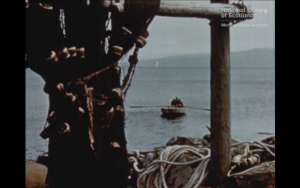
"A Joint Production Committee film, complete with 'Teaching Notes', which sets out to describe the Skye crofter's seasonal employment in the salmon fishing industry of the 1930s." (EAFA Database)
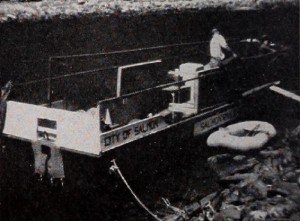
"Spanning the upper and narrower part of the State of Idaho from east to west, the Salmon River provides the original blueprint for one-way traffic. You either end up in western Idaho — or at the bottom of the river. Frank E. Gunnell ended up in Idaho. His coverage of this adventurous journey in The Salmon — River Of No Return is complete, carefully planned and splendidly competent. One becomes thoroughly familiar with the great, flat-bottomed barge, guided by giant sweeps fore and aft, in which the hazardous rapids of the Salmon are surmounted. One is charmed, even fascinated, by the deserted mining huts along the river and the few forlorn characters who still live amid this rocky wilderness. The Salmon — River Of No Return is a leisurely and well made record of a unique vacation adventure." Movie Makers, Dec. 1948, 492.
"Girl Guides from Queen Margaret's School collect scrap metal and other materials for the war effort" British Columbia Archives.
This film may also be known as Queen Margaret School Salvage Drive, World War Two.
"This picture was given first prize in the Los Angeles Cinema Club annual contest." American Cinematographer, Feb. 1936, 73.
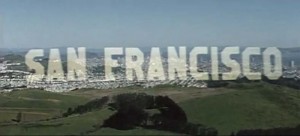
San Francisco "...is a 16mm Filmorama travelogue of San Francisco in 1955 that employs a conventional structure and makes emphatic use of the widescreen equipment. The film’s use of traveling car shots, or updated phantom rides, heightens our sense of being in motion, much like early Cinerama films. This is no rough home movie; it is a very polished travelogue and was shown before an audience of five hundred amateurs at a Bay Area amateur screening the year it was produced" Tepperman, 125.
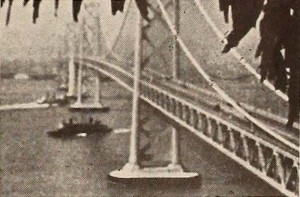
"To present, on 8mm. Kodachrome, where the problem of definition in distant shots is made more difficult by the greater screen enlargement in projection, a serious and satisfying architectural study of a structure that extends not a few hundred feet into the air, but thousands of feet horizontally, is a task that calls for skill in movie making. Raymond O'Connell, in San Francisco — Oakland Bay Bridge, has exhibited that skill and has to his credit, in this film, a definite accomplishment. The study is rendered comprehensible to the audience, at the very outset, by the use of a model of the bridge, which is introduced in the course of the picture, with excellent effect. In several instances, one passes from a shot of the model to another of the actual structure from the same angle, and so easily that it is possible to forget the cinematic labor put forth in finding a vantage point for the camera to show exactly what was needed. Of especial merit are shots of the changing pattern of the cables, made from a moving motor car, which provide a fine essay in abstract design." Movie Makers, Dec. 1938, 620.
"Footage of the Behrens family on holiday in Sandsend; June 1925. Includes various scenes of the family on the beach - Two men are seen wading through the sea, carrying a man and a boy to dry land. A large rowing boat is seen anchored in the background. - Three little girls stand on top of a sand castle, trying desperately to keep their feet dry, while a young boy shovels sand around them in an attempt to keep the in coming tide at bay. - A group of women are seen standing on a breezy hillside, dressed in outdoor clothing, carrying rucksacks and walking sticks. The film also features a brief shot of a London North Eastern Railway (L.N.E.R.) steam train departing from a platform" (NWFA Online Database).
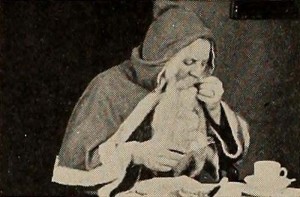
"Santa Passes Out is another of John Martin's delightful pictures of family life, a subject which he handles con amore. A series of unusually fine child studies makes this film outstanding, and the utterly spontaneous character of most of this material is all the more praiseworthy because every bit of it carries the story forward. Mr. Martin did not succumb to the sore temptation that besets the producer parent, to insert an irrelevant shot here and there because it is "so cute." The story itself is a gentle narration of the inevitable expose that awaits the fond parent when he impersonates Santa Claus, and the film as a whole is completely delightful. There is unusually good interior color photography throughout and a very clever, double exposed main title." Movie Makers, Dec. 1938, 597.
"'Santa Visits Elaine,' 16mm. in color, by John E. Pohl of Cicero, Ill., was the winner in the home movies class. The picture is finely done. It greets you with an unusually strong title when it flashes upon you on the screen. No filters are used. There are few characters in the story—as a matter of fact Elaine and her mother carry the greater burden of the cast. To be sure, Santa is in the limelight long enough to do a little tree and interior decorating. Elaine looks a trifle large to accept as gospel truth all the conversation sometimes handed to children about the comings and goings of Santa Claus, but the young lady does or is caused to do one good deed which may indicate one of two things: either she is going to do her utmost to entertain Santa while he is visiting that house or else she has a line on the habits of the male person who is in her mind slated to do the hanging. She very prominently places a bottle of beer and a large glass right where the visitor cannot miss it. Does he miss it? No, he does not. In spite of the obstacle presented by the phoney mustaches he gets around them." American Cinematographer, Jan. 1939, 17.
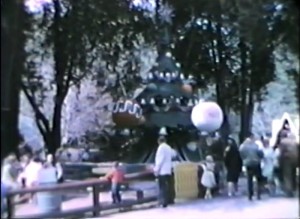
"A tour of the California theme park." Center for Home Movies.
Total Pages: 203